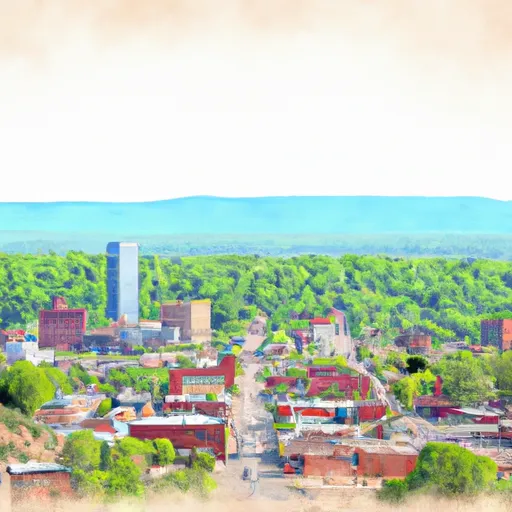-
 Snoflo Premium
Snoflo Premium
Get unlimited access to all our content
With no Ad interruptions! - Start Your Free Trial Login with existing account
Pottsville
Eden Index
Climate
8.0
•
Recreation
5.1
•
Community
2.7
•
Safeguard
5.6/10

Pottsville, Arkansas, is a small town located in Pope County. The climate in Pottsville is characterized by hot and humid summers, with temperatures often reaching the high 90s°F (32-37°C), and mild winters, with temperatures averaging around 40-50°F (4-10°C). The area experiences a moderate amount of rainfall throughout the year, with the wettest months being in spring and early summer.
Hydrologically, Pottsville is situated near the Arkansas River and has access to several creeks and streams. These water sources provide opportunities for fishing, boating, and other water-based activities. The area is known for its diverse aquatic life, with popular fish species including bass, catfish, and crappie.
Outdoor recreation enthusiasts will find various opportunities in Pottsville. The town is surrounded by picturesque landscapes and offers hiking trails, camping sites, and picnic areas in nearby natural areas. Additionally, there are opportunities for hunting, bird-watching, and wildlife observation in the surrounding forests.
Overall, Pottsville, Arkansas, offers a pleasant climate, access to waterways, and a range of outdoor recreation opportunities, making it an appealing destination for nature enthusiasts.
What is the Eden Index?
The Snoflo Eden Index serves as a comprehensive rating system for regions, evaluating their desirability through a holistic assessment of climate health, outdoor recreation opportunities, and natural disaster risk, acknowledging the profound impact of these factors on livability and well-being.
Climate Health Indicator (CHI): 8.0
Pottsville receives approximately
1259mm of rain per year,
with humidity levels near 84%
and air temperatures averaging around
16°C.
Pottsville has a plant hardyness factor of
7, meaning
plants and agriculture in this region tend to thrive during the non-winter months.
By considering the ideal temperature range, reliable water supplies, clean air, and stable seasonal rain or snowpacks, the Climate Health Indicator (CHI) underscores the significance of a healthy climate as the foundation for quality living.
A healthy climate is paramount for ensuring a high quality of life and livability in a region, fostering both physical well-being and environmental harmony. This can be characterized by ideal temperatures, reliable access to water supplies, clean air, and consistent seasonal rain or snowpacks.
Weather Forecast
Streamflow Conditions
Lower Arkansas-Fourche La Fave
Area Rivers
Lower Arkansas-Fourche La Fave
Snowpack Depths
Lower Arkansas-Fourche La Fave
Reservoir Storage Capacity
Lower Arkansas-Fourche La Fave
Groundwater Levels
Recreational Opportunity Index (ROI): 5.1
The Recreational Opportunity Index (ROI) recognizes the value of outdoor recreational options, such as parks, hiking trails, camping sites, and fishing spots, while acknowledging that climate plays a pivotal role in ensuring the comfort and consistency of these experiences.
Access to outdoor recreational opportunities, encompassing activities such as parks, hiking, camping, and fishing, is crucial for overall well-being, and the climate plays a pivotal role in enabling and enhancing these experiences, ensuring that individuals can engage in nature-based activities comfortably and consistently.
Camping Areas
| Campground | Campsites | Reservations | Toilets | Showers | Elevation |
|---|---|---|---|---|---|
| Coyote Camp Complex | 13 | 367 ft | |||
| Turkey Trot Complex | 25 | 261 ft | |||
| Dogwood Complex | 12 | 174 ft | |||
| Lotus Camp | 20 | 215 ft | |||
| Lake Claiborne State Park | None | 337 ft | |||
| Cloud Crossing Complex | 13 | 130 ft | |||
| Kisatchie Bayou Complex | 30 | 167 ft | |||
| Oak Camp Complex | 23 | 300 ft | |||
| Custis Camp Complex | 10 | 302 ft | |||
| Red Bluff Camp Complex | 10 | 205 ft |
Nearby Ski Areas
Catastrophe Safeguard Index (CSI):
The Catastrophe Safeguard Index (CSI) recognizes that natural disaster risk, encompassing floods, fires, hurricanes, and tornadoes, can drastically affect safety and the overall appeal of an area.
The level of natural disaster risk in a region significantly affects safety and the overall livability, with climate change amplifying these risks by potentially increasing the frequency and intensity of events like floods, fires, hurricanes, and tornadoes, thereby posing substantial challenges to community resilience and well-being.
Community Resilience Indicator (CRI): 2.7
The Community Resilience Indicator (CRI) recognizes that education, healthcare, and socioeconomics are crucial to the well-being of a region. The CRI acknowledges the profound impact of these elements on residents' overall quality of life. By evaluating educational resources, healthcare accessibility, and economic inclusivity, the index captures the essential aspects that contribute to a thriving community, fostering resident satisfaction, equity, and social cohesion.

